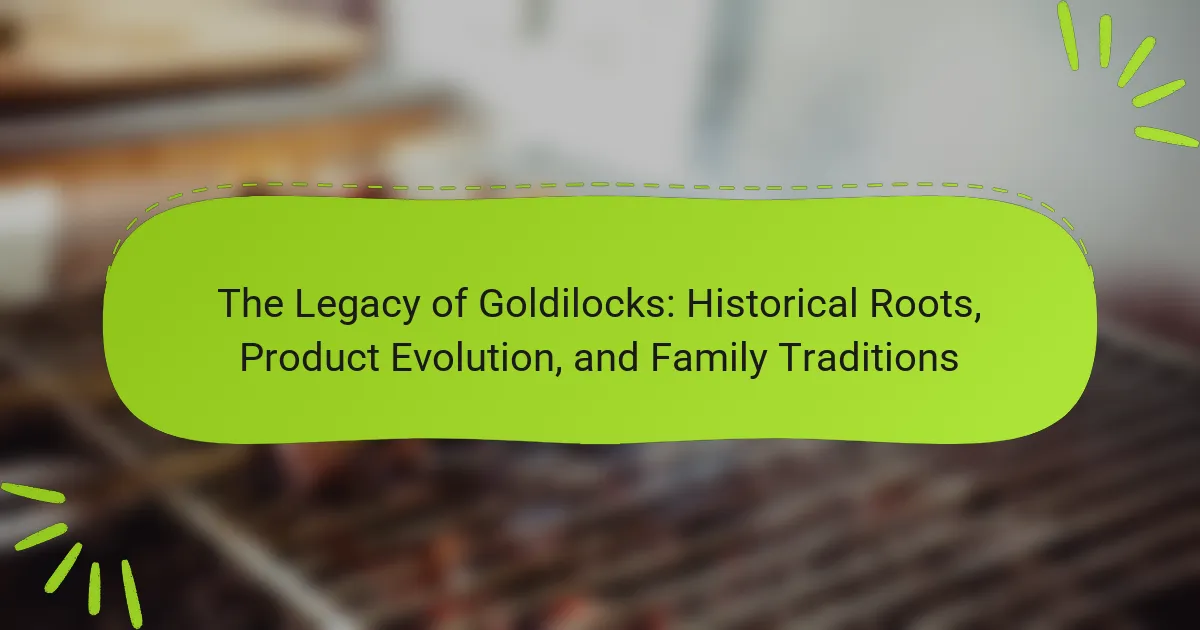The article examines the legacy of Goldilocks, focusing on its historical roots, product evolution, and the influence of family traditions. Goldilocks symbolizes curiosity and the importance of respecting boundaries, with its narrative deeply embedded in cultural storytelling and moral lessons. The brand began with traditional Filipino baked goods and has since expanded its offerings to include a diverse range of products, reflecting modern tastes while maintaining quality and tradition. Additionally, family traditions play a crucial role in shaping consumer experiences with Goldilocks, enhancing the enjoyment of its products and fostering connections within families.

What is the Legacy of Goldilocks?
The legacy of Goldilocks primarily represents a blend of cultural storytelling and moral lessons. This character has become a symbol of curiosity and the consequences of intruding on others’ spaces. The tale emphasizes themes of respect, boundaries, and the importance of understanding different perspectives. Goldilocks’ story has influenced various adaptations in literature and media, showcasing its enduring relevance. Additionally, the narrative has contributed to the development of family traditions centered around storytelling. The character’s journey continues to resonate with audiences, reflecting societal values and childhood experiences.
How did the story of Goldilocks originate?
The story of Goldilocks originated from a 19th-century fairy tale. The earliest version, titled “The Story of the Three Bears,” was published in 1837 by British author Robert Southey. In this tale, a rude old woman enters the house of three bears. The story evolved over time, with Goldilocks replacing the old woman in later adaptations. The character of Goldilocks became popular in children’s literature. The tale emphasizes themes of curiosity and consequences. Today, it remains a classic story told to children worldwide.
What are the key elements of the Goldilocks tale?
The key elements of the Goldilocks tale include Goldilocks, the three bears, and the three different porridge bowls. Goldilocks is a curious girl who enters the bears’ home. The three bears consist of a Papa Bear, Mama Bear, and Baby Bear. Each bear has a unique bowl of porridge with different temperatures: too hot, too cold, and just right. Goldilocks tastes each bowl and finds Baby Bear’s porridge to be just right. Additionally, Goldilocks sits in the bears’ chairs and sleeps in Baby Bear’s bed. These interactions highlight themes of curiosity, consequences, and the idea of finding balance.
How has the narrative evolved over time?
The narrative of Goldilocks has evolved significantly since its inception. Originally, the tale appeared in the early 19th century in various forms. The first published version was by Robert Southey in 1837, featuring an elderly woman rather than a young girl. Over time, the character of Goldilocks transformed into a more relatable child figure, appealing to younger audiences. The story’s themes shifted from cautionary tales to lessons about curiosity and adventure. Modern adaptations often emphasize friendship and family values, reflecting contemporary societal norms. This evolution showcases how narratives can adapt to cultural changes while retaining core elements.
What cultural significance does Goldilocks hold?
Goldilocks symbolizes the themes of curiosity and consequences in folklore. The character represents the archetype of a young girl who explores the unknown. Her actions lead to important moral lessons about respect for others’ property. The story illustrates the balance between extremes, as Goldilocks seeks the “just right” option. This concept resonates with the broader cultural emphasis on moderation. The tale has been retold in various cultures, emphasizing its universal appeal. Goldilocks has become a reference point in discussions about personal boundaries and ethical behavior. The story’s enduring popularity reflects its significance in teaching values to children.
How has Goldilocks influenced literature and storytelling?
Goldilocks has significantly influenced literature and storytelling by introducing themes of curiosity and consequence. The character embodies the archetype of the innocent intruder, exploring spaces that do not belong to her. This narrative structure has inspired countless adaptations and retellings in various cultures. Goldilocks’ interactions with the three bears illustrate moral lessons about respect for boundaries. The story has also contributed to the development of the “fairy tale” genre, shaping expectations for character development and plot progression. Scholars often cite Goldilocks as a foundational figure in children’s literature, emphasizing her role in teaching young readers about decision-making and consequences. The story’s enduring popularity demonstrates its impact on storytelling conventions, making it a staple in literary studies.
What lessons can be learned from the Goldilocks story?
The Goldilocks story teaches important lessons about boundaries and respect for others’ property. Goldilocks enters the bears’ home without permission. This act illustrates the importance of consent and respecting personal space. Additionally, the story highlights the consequences of actions. Goldilocks faces the bears’ anger upon discovery. This emphasizes accountability for one’s behavior. Finally, the varying porridge temperatures represent individual preferences. It suggests that finding balance is essential in life. These lessons resonate through various cultural interpretations of the tale.

What is the evolution of Goldilocks products?
Goldilocks products have evolved significantly since their inception. Initially, Goldilocks focused on traditional Filipino baked goods. The company began with simple offerings like cakes and pastries. Over the years, they expanded their menu to include a variety of products. This includes savory snacks and Filipino delicacies. The introduction of modern flavors and innovative recipes marked a key evolution stage. Goldilocks also embraced seasonal and festive products to cater to customer preferences. Their commitment to quality and tradition remains evident in every product. Today, Goldilocks is recognized as a staple in Filipino celebrations and daily life.
How did Goldilocks transition from folklore to food products?
Goldilocks transitioned from folklore to food products through branding and cultural adaptation. The character became associated with the idea of finding the “just right” experience. This concept resonated with consumers looking for quality and satisfaction in food. In the Philippines, the Goldilocks brand was established in 1966. It began as a small bakery and grew into a well-known food company. The brand capitalized on the story’s themes to market cakes, pastries, and other baked goods. Goldilocks products emphasize quality and taste, aligning with the original folklore’s message. The brand’s success illustrates how folklore can evolve into a commercial entity.
What types of products are associated with the Goldilocks brand?
Goldilocks is primarily associated with baked goods and Filipino delicacies. The brand offers a variety of products including cakes, pastries, and breads. Popular items include their signature Goldilocks cakes, such as the chocolate mousse and mango mousse. They also provide traditional Filipino snacks like ensaymada and bibingka. Goldilocks has expanded its product line to include savory items, such as lumpia and pancit. The brand is well-known for its celebration cakes tailored for special occasions. These offerings reflect the brand’s commitment to quality and tradition in Filipino cuisine. Goldilocks has been a staple in the Philippines since its founding in 1966, further solidifying its reputation in the baked goods market.
How have product offerings changed over the years?
Product offerings have evolved significantly over the years at Goldilocks. Initially, the brand focused on traditional baked goods like cakes and pastries. As consumer preferences shifted, Goldilocks expanded its range to include savory items and snacks. The introduction of modern flavors and innovative recipes has attracted a younger demographic. Seasonal and limited-edition products have also become more common. Additionally, the brand has embraced healthier options in response to growing health consciousness. This evolution reflects a commitment to meet diverse customer needs and preferences. Goldilocks’ adaptability has solidified its position in the market.
What innovations have shaped Goldilocks products?
Goldilocks products have been shaped by innovations in baking technology and product variety. The introduction of automated baking equipment improved consistency and efficiency in production. Advances in food preservation techniques extended product shelf life, enhancing customer satisfaction. Goldilocks also innovated by introducing a diverse range of flavors and offerings, catering to evolving consumer preferences. Seasonal and festive products have been developed to meet cultural celebrations. Additionally, packaging innovations have enhanced product visibility and convenience for consumers. These innovations have contributed to Goldilocks’ reputation as a leading brand in the baked goods market.
How does Goldilocks incorporate modern trends into its offerings?
Goldilocks incorporates modern trends by introducing innovative flavors and healthier options. The brand has expanded its menu to include gluten-free and vegan products. This aligns with the growing consumer demand for dietary accommodations. Additionally, Goldilocks embraces digital marketing strategies. They utilize social media platforms to engage with younger audiences. The use of online ordering and delivery services reflects current shopping behaviors. Seasonal promotions and limited-time offerings create excitement and urgency. Overall, Goldilocks adapts to changing consumer preferences while maintaining its traditional roots.
What role does consumer feedback play in product development?
Consumer feedback plays a crucial role in product development. It helps companies understand customer needs and preferences. This information guides design and functionality decisions. Feedback can lead to improvements in product quality and user experience. Companies that actively seek feedback often achieve higher customer satisfaction. Research shows that businesses utilizing consumer feedback can increase their market success by up to 30%. Engaging with consumers fosters loyalty and trust in the brand. This process ultimately drives innovation and competitiveness in the market.

How do family traditions shape the Goldilocks experience?
Family traditions significantly influence the Goldilocks experience by fostering a sense of comfort and familiarity. These traditions often involve shared meals or activities that create lasting memories. For example, families may have specific recipes or rituals around dessert, enhancing the enjoyment of Goldilocks products. This shared experience strengthens family bonds and encourages repeated engagement with the brand. Furthermore, traditions can dictate preferences for flavors or product types, shaping consumer choices. Overall, family traditions personalize the Goldilocks experience, making it more meaningful and memorable.
What traditions are associated with Goldilocks in families?
Traditions associated with Goldilocks in families often include storytelling and bedtime rituals. Many families read the Goldilocks story as part of their children’s bedtime routine. This promotes imagination and moral lessons about respect for others’ property. Additionally, some families create themed activities around the story. These can include making porridge together or discussing the story’s themes. Such traditions foster family bonding and create lasting memories. They also encourage children to engage with literature and develop a love for reading.
How do families celebrate Goldilocks-themed events?
Families celebrate Goldilocks-themed events through various creative activities. They often host birthday parties inspired by the story. Decorations feature bears and Goldilocks imagery. Themed games may include bear hunts or porridge tasting. Families might read the Goldilocks story together during the event. Food often includes porridge and bear-shaped treats. Costumes of Goldilocks and bears are popular among children. These celebrations foster imagination and family bonding.
What role do Goldilocks products play in family gatherings?
Goldilocks products serve as essential contributions to family gatherings. They provide a sense of nostalgia and tradition. Many families associate these products with celebrations and special occasions. The variety of offerings, such as cakes and pastries, caters to diverse tastes. This inclusivity fosters a sense of togetherness among family members. Goldilocks products are often shared during meal times, enhancing the communal experience. Their presence can evoke fond memories tied to family rituals. Overall, these products strengthen familial bonds during gatherings.
How can families create their own Goldilocks-inspired traditions?
Families can create their own Goldilocks-inspired traditions by establishing routines that focus on balance and personalization. They can start by choosing activities that suit everyone’s preferences, like family game nights or themed dinners. Each family member can suggest their favorite games or dishes to ensure that the experience is “just right” for all.
Additionally, families can incorporate storytelling sessions where they share their own versions of the Goldilocks tale, allowing for creativity and individual expression. This can foster a sense of belonging and connection among family members.
Families can also set aside time for seasonal traditions, such as creating a cozy reading nook in winter or having outdoor picnics in summer. These traditions can be adjusted based on family feedback to keep them enjoyable and relevant.
By consistently engaging in these balanced activities, families can build lasting memories that reflect their unique dynamics.
What activities can families engage in to honor the Goldilocks legacy?
Families can engage in storytelling sessions to honor the Goldilocks legacy. They can read the original tale of Goldilocks and the Three Bears together. This activity fosters discussion about the story’s themes. Families might also create their own versions of the story. This encourages creativity and imagination. Cooking activities can be organized, like making porridge. This ties back to the story’s central elements. Additionally, families can visit local libraries or museums that feature fairy tales. These outings can deepen understanding of the story’s cultural impact. Engaging in discussions about choices and consequences can also be beneficial. Such conversations can reinforce the moral lessons found in the tale.
How can families incorporate Goldilocks themes into their celebrations?
Families can incorporate Goldilocks themes into their celebrations by focusing on the concepts of balance and moderation. They can create a “just right” atmosphere by selecting decorations that are not too extravagant or too minimalistic. For food, families can prepare a variety of dishes that cater to different tastes, ensuring options that are neither too spicy nor too bland. Activities can include games that emphasize teamwork and finding the right fit for everyone involved. Storytelling sessions featuring Goldilocks can also be a fun way to engage children and highlight the moral of making thoughtful choices. These approaches reflect the essence of the Goldilocks story, promoting harmony in family gatherings.
What are some best practices for enjoying Goldilocks products?
To enjoy Goldilocks products, savor them fresh for the best taste experience. Consume baked goods like cakes and pastries within a few days of purchase. Pair savory items with complementary beverages for enhanced flavor. Share Goldilocks treats with family and friends to create memorable moments. Store products in a cool, dry place to maintain their quality. Experiment with different products to discover personal favorites. Always check expiration dates to ensure freshness. These practices help maximize enjoyment and preserve the legacy of Goldilocks.
How can families choose the best Goldilocks products for their needs?
Families can choose the best Goldilocks products by assessing their specific preferences and needs. They should consider factors such as taste, dietary restrictions, and occasion. Goldilocks offers a variety of products, including cakes, pastries, and savory snacks. Each product has unique flavors and ingredients. Families can read product labels for nutritional information. They can also seek recommendations from friends and family who have tried Goldilocks products. Additionally, online reviews can provide insights into popular items. Sampling different products may help families find their favorites. Goldilocks has a long history of quality, established since 1966, which supports its reputation for reliable products.
What tips can enhance the Goldilocks experience for families?
To enhance the Goldilocks experience for families, create a warm and inviting atmosphere. Use soft lighting and comfortable seating to encourage relaxation. Offer a variety of Goldilocks-themed snacks and treats to engage everyone’s taste preferences. Incorporate storytelling sessions to share the Goldilocks tale, fostering family bonding. Set up interactive activities related to the story, such as crafts or games. Encourage family discussions about the moral lessons of the story, promoting critical thinking. Provide a cozy reading nook with Goldilocks books to inspire imagination. Lastly, celebrate family traditions by revisiting the Goldilocks theme during special occasions.
The main entity of this article is Goldilocks, which encompasses both the traditional fairy tale and the associated food products. The article explores the historical roots of the Goldilocks story, tracing its origins to the 19th century and highlighting its evolution from a cautionary tale to a beloved children’s narrative. It also examines the transformation of Goldilocks into a prominent brand in the food industry, detailing the variety of products offered and how they reflect cultural traditions. Additionally, the article discusses the role of family traditions in enhancing the Goldilocks experience, emphasizing the importance of storytelling and shared meals in creating lasting memories.
